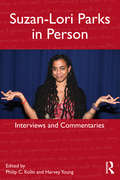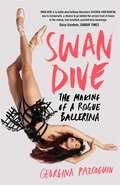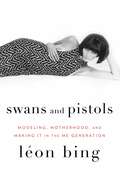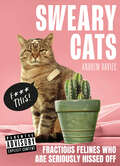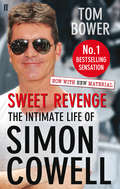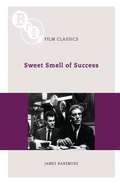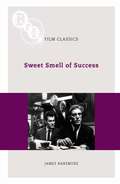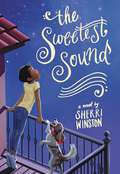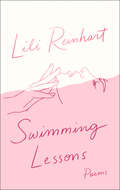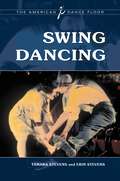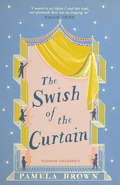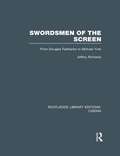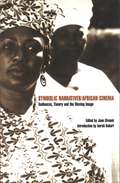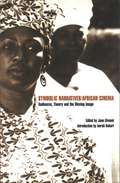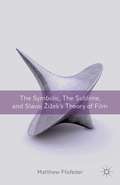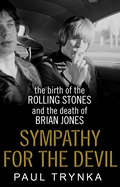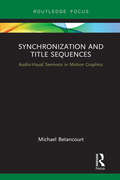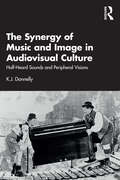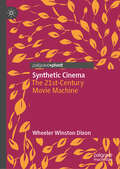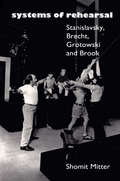- Table View
- List View
Suzan-Lori Parks in Person: Interviews and Commentaries
by Philip C. Kolin Harvey YoungThis collection of interviews offers unprecedented insight into the plays and creative works of Suzan-Lori Parks, as well as being an important commentary on contemporary theater and playwriting, from jazz and opera to politics and cultural memory. Suzan-Lori Parks in Person contains 18 interviews, some previously untranscribed or specially undertaken for this book, plus commentaries on her work by major directors and critics, including Liz Diamond, Richard Foreman, Bonnie Metzgar and Beth Schachter. These contributions combine to honor the first African American woman to receive the Pulitzer Prize in drama, and explore her ideas about theater, history, race, and gender. Material from a wide range of sources chronologically charts Parks’s career from the 1990s to the present. This is a major collection with immediate relevance to students of American/African-American theater, literature and culture. Parks’s engaging voice is brought to the fore, making the book essential for undergraduates as well as scholars.
Swan Dive: The Making of a Rogue Ballerina
by Georgina PazcoguinAward-winning New York City Ballet soloist Georgina Pazcoguin, aka the Rogue Ballerina, gives readers a backstage tour of the real world of elite ballet – the gritty, hilarious, sometimes shocking truth you don’t see from the orchestra circle.In this love letter to the art of dance and the sport that has been her livelihood, NYCB’s first Asian American female soloist Georgina Pazcoguin lays bare her unfiltered story of leaving small-town Pennsylvania for New York City and training amid the unique demands of being a hybrid professional athlete/artist, all before finishing high school. She pitches us into the fascinating, whirling shoes of dancers in one of the most revered ballet companies in the world with an unapologetic sense of humour about the cutthroat, survival-of-the-fittest mentality at NYCB. Some swan dives are literal: even in the ballet, there are plenty of face-plants, backstage fights, late-night parties, and raucous company bonding sessions.Rocked by scandal in the wake of the #MeToo movement, NYCB sits at an inflection point, inching toward progress in a strictly traditional culture, and Pazcoguin doesn’t shy away from ballet’s dark side. She continues to be one of the few dancers openly speaking up against the sexual harassment, mental abuse, and racism that in the past went unrecognized or was tacitly accepted as par for the course – all of which she has painfully experienced firsthand.Tying together Pazcoguin’s fight for equality in the ballet with her infectious and deeply moving passion for her craft, Swan Dive is a page-turning, one-of-a-kind account that guarantees you'll never view a ballerina or a ballet the same way again.
Swans and Pistols: Modeling, Motherhood, and Making It in the Me Generation
by Leon BingFashion icon, Broadway and Hollywood insider, mob mistress, confidante to notorious gang members of both Crips and Bloods, wife, mother, award-winning journalist, Léon Bing has not followed the typical path through life. From her formative relationship with her mother to her days as a star model to her sisterly relationship with Mama Cass Elliot and ultimate reinvention as the author of the bestselling gang exposé, Do or Die, Swans and Pistols details Bing's always exciting and sometimes dangerous life. In a series of riveting stories of unconventionality, Bing wrestles with the themes of mothers, daughters, and reinvention-a concept inseparable from the experience of her early adult life in the 1960s and the city she called home.
Sweary Cats
by Andrew DaviesUnderneath that chilled exterior is a potty-mouthed mouser ready to let rip. Sweary Cats features over 60 fabulous felines itching and scratching to tell it like it is, either through withering sarcasm or deeply insulting remarks.
Sweet Revenge: Updated Edition
by Tom BowerIlluminating the life of Simon Cowell and delving into backstage scandal, tabloid rumour and the cut-throat worlds of music and television, Tom Bower leaves no stone unturned in this must-read biography. This is a detailed insider's account of entertainment mogul Simon Cowell's rise to meteoric fame and all of the controversial highs and lows along the way. Packed with juicy details, exclusive interviews and sensational revelations, Sweet Revenge is an incredible portrait of Simon Cowell which also uncovers the real stories behind The X Factor, Britain's Got Talent and American Idol. Tom Bower is the author of nineteen books, including biographies of Robert Maxwell, Mohamed Fayed, Gordon Brown, Richard Branson, Conrad Black and, more recently, Bernie Ecclestone.
Sweet Smell of Success (BFI Film Classics)
by James NaremoreThe highest artistic achievement of Hecht-Hill-Lancaster, an innovative production company that emerged in Hollywood at the end of the classic studio system, Sweet Smell of Success (1957) portended the collapse of Breen-Office censorship and was the first US entertainment film to depict McCarthy-style exploitation of the press. It also presented an unusually dark view of the culture of celebrity, presaging developments of an even darker kind in our own day. Sweet Smell's frightening portrayal of a newspaperman loosely based on Walter Winchell and its unstinting depiction of corruption and sleaze in the world of Broadway theatres and nightclubs have given it a legendary reputation; critics and film-makers continue to praise the whiplash dialogue of Clifford Odets and Ernest Lehman, the seductive location photography of James Wong Howe, the stylish direction of Alexander Mackendrick and the disturbing performances of Burt Lancaster and Tony Curtis as ruthless gossip columnist J. J. Hunsecker and his ambitious but doomed acolyte, Sidney Falco.James Naremore's masterly study of Sweet Smell of Success offers new information about the many revisions of the screenplay, the production company's negotiations with censors and the tense circumstances under which the film was shot and received by the public. Naremore places the film in its historical context, arguing that it functioned as the revenge of the Hollywood left against a repressive political and media environment that was beginning to change and momentarily lose its power. He also provides a detailed commentary on the finished product, analysing the important contributions of its several talented creators.
Sweet Smell of Success (BFI Film Classics)
by James NaremoreThe highest artistic achievement of Hecht-Hill-Lancaster, an innovative production company that emerged in Hollywood at the end of the classic studio system, Sweet Smell of Success (1957) portended the collapse of Breen-Office censorship and was the first US entertainment film to depict McCarthy-style exploitation of the press. It also presented an unusually dark view of the culture of celebrity, presaging developments of an even darker kind in our own day. Sweet Smell's frightening portrayal of a newspaperman loosely based on Walter Winchell and its unstinting depiction of corruption and sleaze in the world of Broadway theatres and nightclubs have given it a legendary reputation; critics and film-makers continue to praise the whiplash dialogue of Clifford Odets and Ernest Lehman, the seductive location photography of James Wong Howe, the stylish direction of Alexander Mackendrick and the disturbing performances of Burt Lancaster and Tony Curtis as ruthless gossip columnist J. J. Hunsecker and his ambitious but doomed acolyte, Sidney Falco.James Naremore's masterly study of Sweet Smell of Success offers new information about the many revisions of the screenplay, the production company's negotiations with censors and the tense circumstances under which the film was shot and received by the public. Naremore places the film in its historical context, arguing that it functioned as the revenge of the Hollywood left against a repressive political and media environment that was beginning to change and momentarily lose its power. He also provides a detailed commentary on the finished product, analysing the important contributions of its several talented creators.
The Sweetest Sound
by Sherri WinstonA story of family, faith, and following your heart For ten-year-old Cadence Jolly, birthdays are a constant reminder of all that has changed since her mother skipped town with dreams of becoming a singing star. Cadence inherited that musical soul, she can't deny it, but otherwise she couldn't be more different - she's as shy as can be. She did make a promise last year that she would try to break out of her shell, just a little. And she prayed that she'd get the courage to do it. As her eleventh birthday draws near, she realizes time is running out. And when a secret recording of her singing leaks and catches the attention of her whole church, she needs to decide what's better: deceiving everyone by pretending it belongs to someone else, or finally stepping into the spotlight. In a story filled with whimsy and hope, Sherri Winston inspires readers to embrace the voice within.
Swimming Lessons: Poems
by Lili ReinhartI seem to be your new favorite novel. One that keeps you up at night, turning my pages. Fingers lingering on me so you don’t lose your place.
Swing Dancing (The American Dance Floor)
by Tamara Stevens Erin StevensTelling a riveting true story of the emergence and development of an American icon, this book traces swing dancing from its origins to its status as a modern-day art form.From its unlikely origins in the African slave trade, one of the saddest chapters of American history, swing dance emerged as a celebration of the soul. Swing is now recognized around the globe as a joyous partnered dance, uniquely Afro-American in origin and an American treasure. This book examines how the original swing style of the 1920s, the Lindy Hop, branched out and evolved with the changing dynamics of popular culture, paralleling the development of the nation. Swing Dancing covers the dance through the years of minstrelsy, the jazz age, the big band era, bebop, and the decline of partnered dancing in the 1960s. Swing experts and instructors Tamara and Erin Stevens have combined a compelling historic examination of swing dance with an assortment of riveting personal interviews and photographic documentation to create a comprehensive reference book on this important art form.
The Swish of the Curtain: Blue Door 1 (Blue Door #1)
by Pamela BrownThe classic story of seven children with a longing to be on stage: the inspiration for actors from Maggie Smith to Eileen Atkins'An enchanting book. A must for any child who wants to become an actor' --Eileen Atkins'And now,' said Nigel, 'the big event. The play, which has got to be exciting.''And serious,' added Vicky.'And colourful,' put in Sandra.'And emotional,' said Lyn.'But not sloppy,' urged Bulldog.What starts as a game during the holidays soon transforms the four girls – Lyn, Sandra, Vicky and Maddy – and three boys – Bulldog, Nigel and Jeremy – into the Blue Door Theatre Company, producing everything from scripts and sets to music and costumes. They are also learning that the show must go on, even in the face of their arch-enemy, Mrs Potter-Smith, a disapproving local institution.But what a show it will be for them all...Pamela Brown (1924–1989) was a British writer, actor and television producer. She was just fourteen when she started writing her first book, and the town of Fenchester in the book is inspired by her home town of Colchester. During the Second World War, she went to live in Wales, so The Swish of the Curtain was not published until 1941, when she was sixteen. She used the earnings from the books to train at RADA, and became an actor and a producer of children's television programmes.
Swordsmen of the Screen: From Douglas Fairbanks to Michael York (Routledge Library Editions: Cinema)
by Jeffrey RichardsThis fascinating study of the genre of swashbuckling films received wide critical acclaim when it was first published in 1977. Jeffrey Richards assesses the contributions to the genre of directors, designers and fencing masters, as well as of the stars themselves, and devotes several chapters to the principal subjects if the swashbucklers – pirates, highwaymen, cavaliers and knights. The result is to recall, however fleetingly, the golden days of the silver screen. Reviews of the original edition: ‘An intelligent, scholarly, well-written account of adventure films, this work is sensitive both to cinema history and to the literary origins of the "swashbuckler"….Essential for any library with books on film, it may very well be the definitive book on its subject.’ – Library Journal
Swordsmen of the Screen: From Douglas Fairbanks to Michael York (Routledge Library Editions: Cinema)
by Jeffrey RichardsThis fascinating study of the genre of swashbuckling films received wide critical acclaim when it was first published in 1977. Jeffrey Richards assesses the contributions to the genre of directors, designers and fencing masters, as well as of the stars themselves, and devotes several chapters to the principal subjects if the swashbucklers – pirates, highwaymen, cavaliers and knights. The result is to recall, however fleetingly, the golden days of the silver screen. Reviews of the original edition: ‘An intelligent, scholarly, well-written account of adventure films, this work is sensitive both to cinema history and to the literary origins of the "swashbuckler"….Essential for any library with books on film, it may very well be the definitive book on its subject.’ – Library Journal
Symbolic Narratives/African Cinema: Audiences, Theory and the Moving Image
by June GivanniIn the conference Africa and the History of Cinematic Ideas held in London in 1995, film-makers, cultural theorists and critics gathered to debate a range of issues. Views were exchanged on such topics as imperialism, and the problems of distribution.
Symbolic Narratives/African Cinema: Audiences, Theory and the Moving Image
In the conference Africa and the History of Cinematic Ideas held in London in 1995, film-makers, cultural theorists and critics gathered to debate a range of issues. Views were exchanged on such topics as imperialism, and the problems of distribution.
The Symbolic, the Sublime, and Slavoj Zizek's Theory of Film
by M. FlisfederReturning to questions about ideology and subjectivity, Flisfeder argues that Slavoj Žižek's theory of film aims to re-politicize film studies and film theory, bringing cinema into the fold of twenty-first century politics.
Sympathy for the Devil: The Birth of the Rolling Stones and the Death of Brian Jones
by Paul TrynkaThe story of the Rolling Stones is one of the epic rock 'n' roll yarns of our time. Their music defined today's cultural landscape and their history is a source of endless fascination for music fans around the world. Yet one crucial part of that story has never been comprehensively analysed: the role of Brian Jones, the visionary who founded the band and controlled their early music down to the smallest detail.Drawing on over one hundred interviews with key principals including Keith Richards, Andrew Oldham and Marianne Faithfull, this is a story told from a totally new perspective and which lays bare the shocking ruthlessness, internal warfare and sexual competition within this most legendary of bands. As well as exploring Jones' crucial role in the Stones' music, it will also investigate the unravelling of his psyche, as observed by Brian's family, friends, bandmates, lovers and enemies. Victors get to write the history - but it's never wholly true. Brian's life story is a gripping one, an epic battle between creativity and ambition, between self-sabotage and betrayal. This book will disentangle the threads of the Rolling Stones story and put Brian Jones firmly in the foreground.
(Syn)aesthetics: Redefining Visceral Performance
by J. MachonA timely book that identifies the practice of '(syn)aesthetics' in artistic style and audience response, which helps to articulate the power of experiential practice in the arts. This exciting new approach includes interviews with leading practitioners in of theatre, dance, site-specific work, live art and technological performance practice.
Synchronization and Title Sequences: Audio-Visual Semiosis in Motion Graphics (Routledge Studies in Media Theory and Practice)
by Michael BetancourtSynchronization and Title Sequences proposes a semiotic analysis of the synchronization of image and sound in motion pictures using title sequences. Through detailed historical close readings of title designs that use either voice-over, an instrumental opening, or title song to organize their visuals—from Vertigo (1958) to The Player (1990) and X-Men: First Class (2011)—author Michael Betancourt develops a foundational framework for the critique and discussion of motion graphics’ use of synchronization and sound, as well as a theoretical description of how sound-image relationships develop on-screen.
Synchronization and Title Sequences: Audio-Visual Semiosis in Motion Graphics (Routledge Studies in Media Theory and Practice)
by Michael BetancourtSynchronization and Title Sequences proposes a semiotic analysis of the synchronization of image and sound in motion pictures using title sequences. Through detailed historical close readings of title designs that use either voice-over, an instrumental opening, or title song to organize their visuals—from Vertigo (1958) to The Player (1990) and X-Men: First Class (2011)—author Michael Betancourt develops a foundational framework for the critique and discussion of motion graphics’ use of synchronization and sound, as well as a theoretical description of how sound-image relationships develop on-screen.
The Synergy of Music and Image in Audiovisual Culture: Half-Heard Sounds and Peripheral Visions
by K.J. DonnellyThe Synergy of Music and Image in Audiovisual Culture: Half-Heard Sounds and Peripheral Visions asks what it means to understand music as part of an audiovisual whole, rather than separate components of music and film. Bringing together revised and updated essays on music in a variety of media – including film, television, and video games – this book explores the importance of partially perceived and registered auditory and visual elements and cultural context in creating unique audiovisual experiences. Critiquing traditional models of the film score, The Synergy of Music and Image in Audiovisual Culture enables readers across music, film, and cultural studies to approach and think about audiovisual culture in new ways.
The Synergy of Music and Image in Audiovisual Culture: Half-Heard Sounds and Peripheral Visions
by K.J. DonnellyThe Synergy of Music and Image in Audiovisual Culture: Half-Heard Sounds and Peripheral Visions asks what it means to understand music as part of an audiovisual whole, rather than separate components of music and film. Bringing together revised and updated essays on music in a variety of media – including film, television, and video games – this book explores the importance of partially perceived and registered auditory and visual elements and cultural context in creating unique audiovisual experiences. Critiquing traditional models of the film score, The Synergy of Music and Image in Audiovisual Culture enables readers across music, film, and cultural studies to approach and think about audiovisual culture in new ways.
Synthetic Cinema: The 21st-Century Movie Machine
by Wheeler Winston DixonIn this book, Wheeler Winston Dixon argues that 21st-century mainstream filmmaking is increasingly and troublingly dominated by "synthetic cinema." He details how movies over the last two decades have fundamentally abandoned traditional filmmaking values through the overwhelming use of computer generated imagery, digital touch ups for the actors, and extensive use of green screen technology that replace sets and location shooting. Combined with the shift to digital cinematography, as well as the rise of comic book and franchise cinema, the temptation to augment movies with lavish, computer generated spectacle has proven irresistible to both directors and audiences, to the point that, Dixon argues, 21st-century commercial cinema is so far removed from the real world that it has created a new era of flawless, fake movies.
Systems of Rehearsal: Stanislavsky, Brecht, Grotowski, and Brook
by Shomit MitterThe gap between theory and practice in rehearsal is wide. many actors and directors apply theories without fully understanding them, and most accounts of rehearsal techniques fail to put the methods in context. Systems of Rehearsal is the first systematic appraisal of the three principal paradigms in which virtually all theatre work is conducted today - those developed by Stanislavsky, Brecht and Grotowski. The author compares each system ot the work of the contemporary director who, says Mitter, is the Great Imitator of each of them: Peter Brook. The result is the most comprehensive introduction to modern theatre available.
Systems of Rehearsal: Stanislavsky, Brecht, Grotowski, and Brook
by Shomit MitterThe gap between theory and practice in rehearsal is wide. many actors and directors apply theories without fully understanding them, and most accounts of rehearsal techniques fail to put the methods in context. Systems of Rehearsal is the first systematic appraisal of the three principal paradigms in which virtually all theatre work is conducted today - those developed by Stanislavsky, Brecht and Grotowski. The author compares each system ot the work of the contemporary director who, says Mitter, is the Great Imitator of each of them: Peter Brook. The result is the most comprehensive introduction to modern theatre available.
